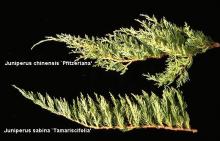Juniperus chinensis 'Pfitzeriana'
Common name:
Pfitzer Juniper
Pronunciation:
ju-NIP-er-us chi-NEN-sis
Family:
Cupressaceae
Genus:
Synonyms:
J. × pfitzeriana [Pfitzer Group]
J. × media ‘Pfitzeriana’
Type:
Conifer
Native to (or naturalized in) Oregon:
No
- Conifer, evergreen, wide spreading shrub, 5 ft x 10 ft, (1.5-3 m), main branches emerge at a 45° angle and young shoots are slightly pendulous (tips drooping). A male plant, hence fruitless. Leaves scale-like, light green, also juvenile leaves that are awl-shaped (needle-like), in whorls of 4 inside the plant.
- Sun and partial shade. Can withstand difficult growing conditions in urban areas or at the seashore. One of the more widely planted junipers. At least a dozen clones (branch sports) have been developed from 'Pfitzeriana'. (Dirr, 1998,. p. 506; Krüssmann, 1985, p. 140, under J. × media).
- Hardy to USDA Zone 4 Now considered a hybrid of J. chinensis and J. sabina.
-
The Pfitzer Story - a convoluted taxonomic conundrum....solved?.
- In the 1860's David Armand, French missionary and botanist, collected seeds from a naturalized populations of J. chinensis and J. sabina in northern China.
- Armand's herbariums and notes were lost but the seeds ended up at a nursery in Metz, France under the name J. chinensis var. penduala. Male and female clones were produced from the seed and these juniper clones become popular in Europe.
- In the 1890's the Späth Nursery in Germany introduced J. chinensis ‘Pfitzeriana’, a male clone that became one of the most widely plant conifers in the world. The nursery's propagator, Wilhelm Pfitzer, planted the new clone in the nursery's display arboretum, where it remains today.
- Peter van Melle, a New York plantsman, studied living and preserved specimens of J. chinensis ‘Pfitzeriana’ and in 1947 reported his conclusion that it was of hybrid origin, i.e., J. chinensis × J. sabina. He proposed the name J. × media for this purported hybrid. The designation J. × media gained acceptance in many, but not all, important horticultural references.
- However, many years later the Royal Horticultural Society discovered that a Russian plantsman, V. D. Dmitriev, in 1938 used the specific epithet, media, for a hybrid of J. semiglobosa and J. pseudosabina var. turkestanica. Under international nomenclature regulations priority usually holds sway, hence van Melle's name J. × media was rendered illegitimate.
- The hybrid was given the name Juniperus ×pfitzeriana and the shrub in the Späth Nursery arboretum was designated Juniperus ×pfitzeriana ‘Wilhelm Pfitzer’.
-
In 1999, Le Duc, Adams, and Zhong published a study in which they analyzed the DNA of the Pfitzer juniper, related selections, and the purported parents of the hybrid (J. chinensis and J. sabina). Their data support van Melle's conclusion that the Pfitzer juniper is separate from J. chinensis, but rather it is a hybrid of J. chinensis and J. sabina. And according to international regulations, the name of the hybrid is J. × pfitzeriana [Pfitzer Group]. Furthermore, their results indicate that the Pfitzer Group includes the following selections; ‘Fruitlandii’, ‘Gold Coast’, ‘Hetzii’, ‘Compact’, ‘Wilhelm Pfitzer’, ‘Pfitzeriana Aurea’, and ‘Pfitzeriana Glauca’. It is likely that other cultivars will be added to the Pfitzer Group as further DNA analyses are performed.
- This abridged and bulleted version of the Pfitzer Story is on based on an article by Mark Zampardo, American Nurseryman 192(8):32-34(2000) and the report by Le Duc, et al. 1999. HortScience 34(6):1123-1125.
- Oregon State Univ. campus: west of Callahan Hall, at 15th St and Jefferson Ave .





